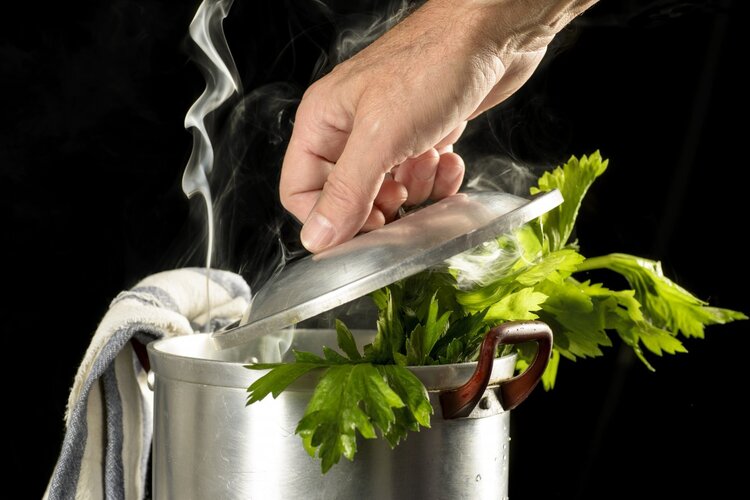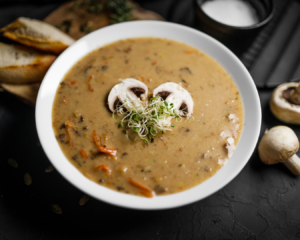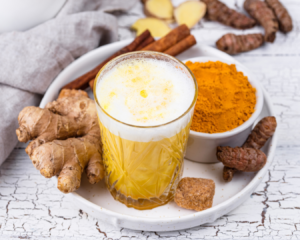Drinking bone broth for its therapeutic effects can be traced back to 60 AD where an army surgeon under Nero wrote about it in his book “De Materia Medica.”
In mid-eighteenth century France, travelers stopping at inns would be treated to bowls of bone broth – then called restoratifs: hence, the origin of the word restaurant – a place to restore one’s health and wellness.
From a variety of cultures, and through our grandparents’ generation – until the industrialization after World War II in the United States – bone broth was a staple of a nutritious way of eating. Use bone broth as a digestive, a palate cleanser, and a drink as do the Cantonese; as “Jewish penicillin” with chicken, vegetables, and matzo balls; or as the basis for rich sauces, gravies and for braising meats as the French as famous for; bone broth is as simple to make as it is universal.
What is Bone Broth?
Bone broth is just what its moniker implies: it’s a broth derived from cooking the bones from chicken, meat or fish in water, over a low heat, for a minimum of twelve hours.
What Makes Bone Broth so Beneficial?
Bone is made mostly of collagen which is the most abundant protein in the body. Collagen is the most important protein in connective tissue, skin and bones. It is a great source of amino acids which are the fundamental building blocks of our tissues.
There are eight essential amino acids which we need to get from food. All eight essential amino acids are found in animal-based foods – meat, dairy, eggs. (The eight essential amino acids can be obtained from a variety of plant-based foods, but careful planning is necessary to guarantee proper amounts.) The amino acids proline, glycine, glutamine and alanine are the key players in the rewards of a good bone broth. They each have beneficial contributions to your nutrient dense tonic.
The intake of collagen ensures the cohesion, elasticity, and regeneration of skin, hair, tendons, ligaments, cartilage, bones, and joints. The body needs collagen to support mobility, strong bones, flexible and strong arteries, healthy skin, and good eyesight. The mucosal lining of the digestive tract is also built from these materials. Some of the supplements that you might purchase in the health food store are contained in the broth, such as glycosaminoglycans, and chrondroitin sulfate.
In addition, one of the eight essential amino acids in collagen, Threonine, supports the cardiovascular, liver, central nervous system, and immune system functions. Threonine also builds up tooth enamel, speeds up wound healing, and with two other amino acids, it prevents the build-up of the accumulation of fat in the liver.
Cooking collagen turns it into gelatin; this is the process by which you reap the benefits of the amino acids. Gelatin is an important key in helping to heal “leaky gut,” – intestinal permeability – and restore the normal mucosal layer in the digestive tract.
Leaky gut is a condition that happens when the epithelial cells of the digestive tract lining are not able to do the job of keeping the undesirable substances from entering the bloodstream such as bacteria, viruses, toxins, undigested food. Anyone who has been under chronic stress, eats large quantities of junk food, takes certain medications regularly ( eg. NSAIDS, ibuprofen), or takes too many rounds of antibiotics could be susceptible to this condition that if not healed can lead to autoimmune disease.
Bone broth:
-
Strengthens and improves joints
-
Improves digestion and heals the digestive tract
-
Strengthens bones
-
Helps to build muscle
-
Improves skin tone by increasing elasticity
-
Improves the condition of hair and nails
-
Improves the quality of sleep
-
Anti-inflammatory
-
Improves immunity
Cooking Bone Broth
Since many toxins can be stored in bones, it is important that you buy from a reputable, organic (if possible for poultry), pastured raised, anti-biotics free source.
For chicken bone broth:
-
1 whole chicken, or the frame of a roasted chicken, or backs, necks and feet
-
2 sweet bay leaves
-
1 tablespoon black peppercorns
-
Any vegetable scraps you have on hand
-
Cover with filtered water and simmer for twelve hours
-
Strain and discard solids, and now you have beautiful broth to drink straight or use to make soup with
-
To store in the freezer, cool, and pour into freezer safe containers
-
Remove fat that has risen to top and save to use for cooking
-
Cool down further in fridge before freezing. Do not forget to leave about 1 inch in top for expansion.
For meat bone broth, use the same ingredients, and cooking method, and include knucklebones and feet to obtain a lot of gelatin, marrowbones for the good fats and flavor, and the shanks and parts with some meat which will impart the treasures of cartilage and meat. Roast the bones before cooking to improve the flavor of the broth.
Additional Sources of Gelatin
If you’re short on time, and aren’t ready to tackle homemade bone broth, you can purchase the pre-made variety from Wise Choice Market or from Thrive Market.
More resources can be found on the Weston A. Price Foundation’s website, a nutrition education foundation group dedicated to promoting the benefits of traditional, preindustrial food and cooking.
On Weston’s website, find local resources. Check out their app at findrealfoodapp.com.
To supplement your fresh broth, healthy versions of the powdered gelatin, which has many uses such as jello, puddings, thickenings for soups, and gravies, can be purchased through Vital Proteins.
For your supplies, use a good stainless steel stockpot or a safe (lead-free) crockpot; I recommend VitaClay Smart Organic Multi-Cooker.
Nowadays, people are returning to the kitchen to prepare homemade, whole foods from scratch. What could be easier than making the superfood, bone broth? The Italians have an expression, tutto fa brodo – “Everything is broth!”







